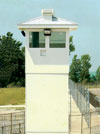
Today, guardhouses are generally placed at the entrance as checkpoints for securing, monitoring and maintaining access control into a secured facility. In the case of small to mid-sized facilities, generally, the entire physical security envelope is controlled from the guardhouse. Come rain or shine, the guardhouse has to stand, protect and defend. And unlike the 18th century, you probably won’t find any sleeping guards.

Using Pre-Fab Versus Stick Built
Early on in the design phase of the gas stations, engineers realized that to protect the equipment necessary for operations they would need structures both to secure and house sensitive equipment and also to provide climate control. They discovered prefab equipment shelters were the most reliable and cost-effective option for their needs.
- Use self-locking doors. “It’s human nature, people will prop them open and then you defeat your security. Plus, when they’re propped open, they waste a whole lot of air conditioning and heating. Also, someone could slip in and place some sort of device inside (tracking or other) that your employee doesn’t detect.”
- Windows are a good idea for a hut that isn’t a manned station. “This may seem counterintuitive, but when your employees enter these unmanned structures, they are blind to what’s going on around them. The most valuable thing you’ve got working for you is the eyes and judgment of your people. Without windows, suddenly they are inside a dark cubicle. I would trade people seeing-in VS my people seeing-out anytime. If people can see in and see that there is nothing of value, you’ll lower break-ins. Because equipment shelters frequently lack windows, break-ins occur more often because thieves think the structures must be protecting something valuable that they can sell.”
- Secure your air conditioning opening. “Most equipment shelters have A/C units to condition the electric equipment. If someone can kick your A/C through the opening, the opening is big enough to crawl through. A bracket, or something that secures your A/C in the hole, is desirable.”
In addition, all Costco gas stations employ security cameras, which include motion sensing capability for efficient nighttime coverage. The cameras are connected to a digital recorder which allows easy review in case we have an incident at our gas stations. All Costo equipment shelters are equipped with door and motion alarms, and are kept locked during the day. Consistent with our company's “belt and suspenders” philosophy, these and other measures comprehensively protect our gasoline systems, said Hurlocker.

The Right Materials
Generally speaking, according to Austin Mohawk, you should buy B/R protection for both a building's glazing (glass windows) and walls, including doors. Again, generally speaking, choose a bullet resistant shroud for a thru wall A/C unit, but do not buy bullet resistant protection for the building's roof or floor which are generally considered extra’s, but can be included if the threat risk so dictates. Some buy only bullet resistant glass, leaving the wall panels unprotected, the company said. Bullet resistant glass usually will have a small label in a bottom corner indicating the level of threat protection and to some buyers implies to employees and/or assailants that the glass is “bullet resistant.”



